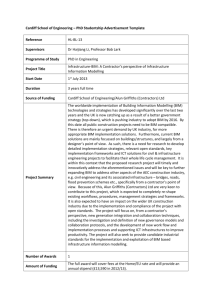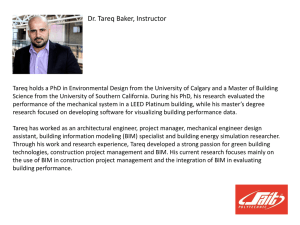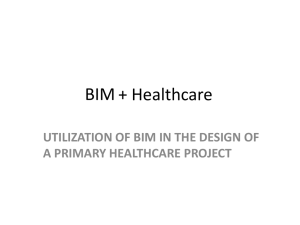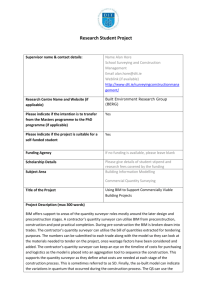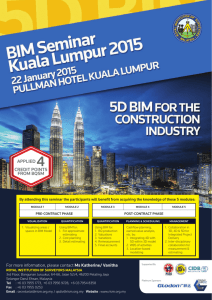AEC Connect - Productivity Commission
advertisement
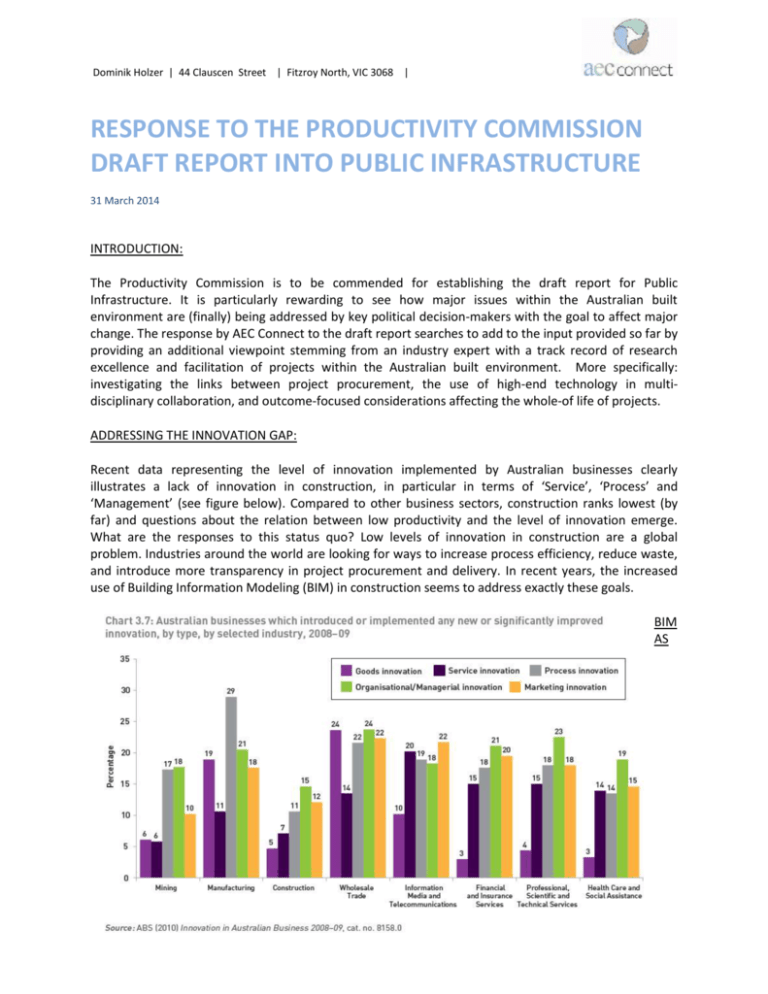
Dominik Holzer | 44 Clauscen Street | Fitzroy North, VIC 3068 | RESPONSE TO THE PRODUCTIVITY COMMISSION DRAFT REPORT INTO PUBLIC INFRASTRUCTURE 31 March 2014 INTRODUCTION: The Productivity Commission is to be commended for establishing the draft report for Public Infrastructure. It is particularly rewarding to see how major issues within the Australian built environment are (finally) being addressed by key political decision-makers with the goal to affect major change. The response by AEC Connect to the draft report searches to add to the input provided so far by providing an additional viewpoint stemming from an industry expert with a track record of research excellence and facilitation of projects within the Australian built environment. More specifically: investigating the links between project procurement, the use of high-end technology in multidisciplinary collaboration, and outcome-focused considerations affecting the whole-of life of projects. ADDRESSING THE INNOVATION GAP: Recent data representing the level of innovation implemented by Australian businesses clearly illustrates a lack of innovation in construction, in particular in terms of ‘Service’, ‘Process’ and ‘Management’ (see figure below). Compared to other business sectors, construction ranks lowest (by far) and questions about the relation between low productivity and the level of innovation emerge. What are the responses to this status quo? Low levels of innovation in construction are a global problem. Industries around the world are looking for ways to increase process efficiency, reduce waste, and introduce more transparency in project procurement and delivery. In recent years, the increased use of Building Information Modeling (BIM) in construction seems to address exactly these goals. BIM AS Dominik Holzer | 44 Clauscen Street | Fitzroy North, VIC 3068 | DECISION SUPPORT FOR PROJECT PROCUREMENT & DELIVERY: As much as BIM-use in practice emerged as a means to increase efficiencies in the (design) consultancy realm (with a strong focus on 3D modeling), it has since gained momentum as a framework for managing building data across a wide range of activities. A number of key objectives listed in the commission’s draft repot relate to the reduction of construction cost, the avoidance of project risk, and the establishment of alternative models of delivery for infrastructure projects. Meeting these objectives, in addition to achieving more certainty and transparency within the delivery process are prerequisites to attract private funding for infrastructure projects. More often than not, those procuring infrastructure projects in Australia seem to have to rely on incomplete information about the expected end-user output as well as other life-cycle aspects of the projects they develop. The construction supply-chain is obfuscated. In addition, the complexity inherent to some infrastructure projects makes it difficult to identify key performance indicators upfront. In this context, the report refers to innovative technology and in particular BIM as promising pathways to introduce more transparency and efficiency to the way projects are delivered. It is argued here that BIM is a fundamental mechanism for introducing process innovation and for facilitating information management throughout the built environment. Implementing BIM goes hand in hand with highly structured supply chain integration and a re-alignment of service facilitation according to standardised protocols that regulate multi-disciplinary collaboration. There is strong evidence to suggest BIM technology is currently facilitating fundamental change within the Australian construction industry. Australia has an alarming lack of information, data and no culture of review (benchmarking) of the performance of its infrastructure. smart – infrastructure facility, University of Wollongong: Green Paper, Infrastructure Imperatives for Australia p.6 There are lessons to be learned for infrastructure from BIM: Starting with knowledge-transfer during project procurement, to project-brief development, design, construction, all the way to operation. BIM can assist to define KPIs for information transfer throughout these major stages and link them to even broader considerations within the built environment. The smart – infrastructure facility green paper by the University of Wollongong points out the lack of information and data for benchmarking the performance of infrastructure in Australia. Elsewhere this problem is being addressed strategically: In the UK, industry and government have jointly established the PAS 1192:21. It is a specification for information management for the capital/delivery phase of construction projects using BIM. Its goal is to achieve maturity Level 2 BIM on all public sector asset procurement, with equal applicability to private sector building, infrastructure, refurbishment and newbuild projects. The PAS 1192:2 also contains guidance notes to identify and benchmark employer’s information requirements (EIRs) upfront across a range of project phases. The above approach highlights the potential the structured BIM process could have on infrastructure. BIM is in no way a ‘complete solution’, but there exists sufficient evidence to suggest that some of the key issues the Productivity Commission aims to respond can be addressed when expanding the BIM methodology to the procurement and delivery of infrastructure projects. In this context, the contractual ‘landscape’ regulating the delivery of construction projects in Australia is worth considering. Dominik 1 http://www.bimtaskgroup.org/pas-1192-22013/ Dominik Holzer | 44 Clauscen Street | Fitzroy North, VIC 3068 | Holzer of AEC Connect has done so as the co-author of a paper titled: Rethinking the contractual context for Building Information Modelling (BIM) in the Australian built environment industry2. There, a procurement approach to BIM is proposed to establish the applicable contractual context to address the potential legal risks and commercial considerations, relative to current practices in Australia. One should highlight that projects procured under PPP contracts by nature tend to include close collaboration of stakeholders across a number of life cycle phases. This in return increases the potential for achieving well-orchestrated multi-party contribution to structured BIM delivery. The use of BIM thereby helps to break down information siloes between government and building contractors. It facilitates better coordination among participating parties, increased transparency in terms of cost and risk allocation, and the opportunity to consider the end-users’ requirements during operation and maintenance early on. KEY PONITS OF ALIGNMENT BETWEEN BIM AND WAYS FOR PROVIDING PUBLIC INFRASTRUCTURE: The potential benefits for increased application of BIM workflows to benefit public infrastructure projects are vast. AEC Connect will provide a short bullet-point list of major opportunities below: Establishing highly accurate and transparent methods for costing based on precision tendering Minimising inefficiencies during project procurement using accurate information/trend analysis Opportunities for weaving macro-economic information via Big Data into life-cycle planning Strategic information management across briefing, planning, construction and operation phases Better decision-support for public and private clients about the impacts of their planning Cutting out inefficiencies in the delivery and management of large and complex projects Increasing sustainability of projects based on better coordination of life-cycle information Reducing waste, both in terms of uncoordinated processes as well as actual build material Drastic reduction of Variations due to better coordinated virtual simulation prior to construction Better accountability of project participants due to well established collaboration protocols Reducing uncertainty and risk in the delivery and ongoing operation/maintenance of projects Tight control of alignment between clients’ specifications and actual project planning/delivery Reduction in labour cost due to better upfront planning, automation, and offsite fabrication Diffusion of process & service innovation in a systemic manner due to broad industry alignment The points listed above represent a starting point for further discussion. They are directly drawn from current experience of Australian construction projects. Knowledge-transfer from these projects to infrastructure provision has already started on a number of developments in Australia. 2 http://epress.lib.uts.edu.au/journals/index.php/AJCEB/article/view/3630 Dominik Holzer | 44 Clauscen Street | Fitzroy North, VIC 3068 | HOW TO?: Being able to identify the opportunities for applying a BIM method in the infrastructure context is only the first step in effecting change in the procurement of Public Infrastructure. What needs to follow is clarification about the mechanisms that ultimately remove the road-blocks for such innovation in order to facilitate productivity gains. Below some of these mechanisms are listed in a brief summary: Offering simple advice to key policy makers on the opportunities of using high-end technology for the procurement, planning, construction and ongoing operation of infrastructure projects Overhaul of current contracts types in consideration of opportunities provided by BIM Responsibility redistribution across project participants based on their capacity to deliver BIM Process Change: Education across the industry, in particular on the client, FM and contractors Changing clients’ perspective from short term gains to life-cycle goals and productivity Defining the role of Government (policy/facilitation) and industry (innovation/implementation) Research: Understand key infrastructure benchmarks and knowledge-transfer from BIM Active engagement with insurers to fine-tune their offerings in the light of BIM collaboration Capturing, evaluating and interrogating knowledge from precedent projects for parametric procurement & tendering Collaboration on Big Data with the Virtual Australia & New Zealand Infrastructure network This list should be seen as a mere starting point for further investigation and AEC Connect is happy to be involved in future discussions. Image: Steve Jones/McGraw Hill: Driverless digger: Illustrating increased automation for site-works




